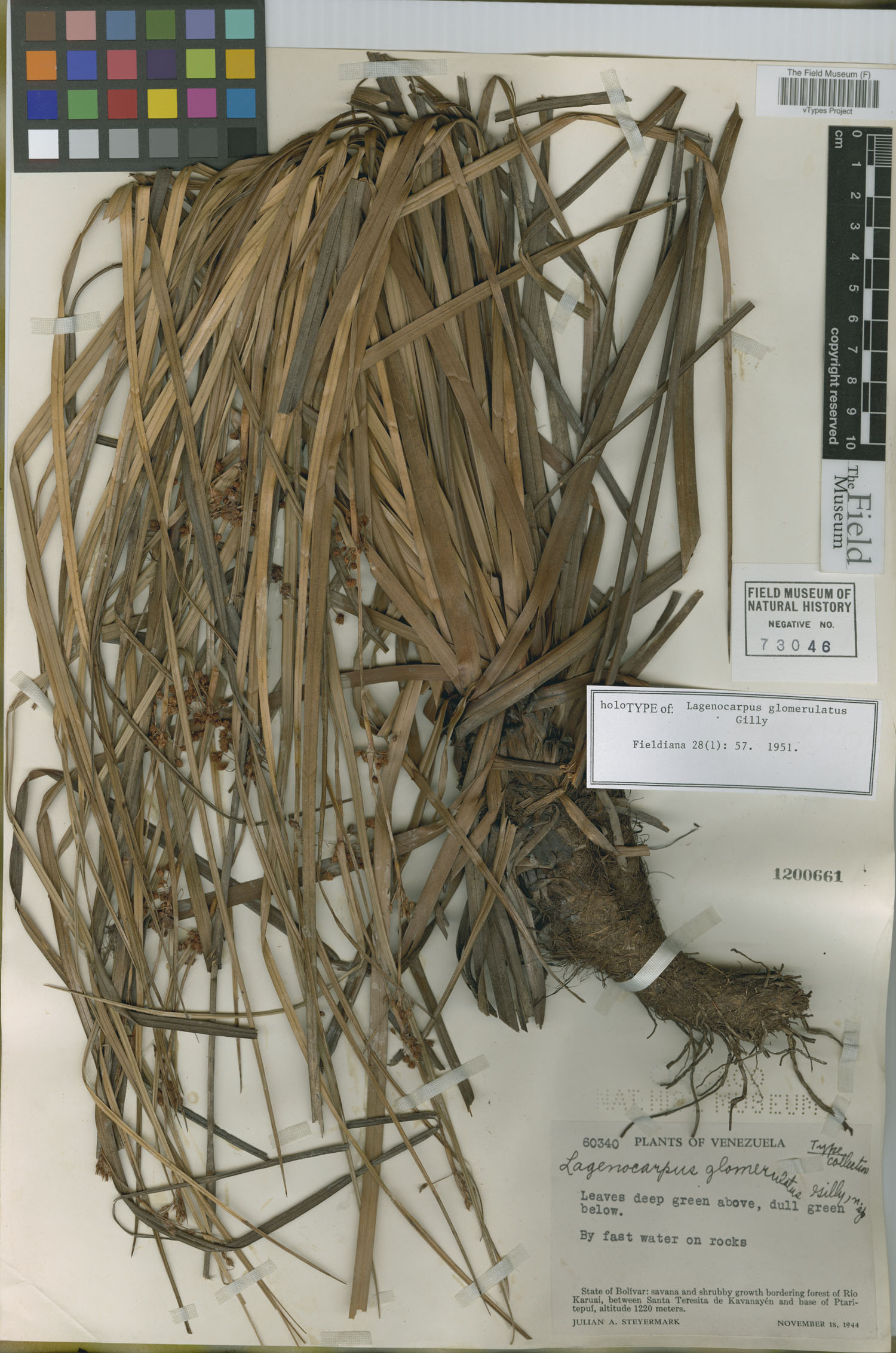Cyperaceae taxon details
Lagenocarpus glomerulatus Gilly
1679458 (urn:lsid:marinespecies.org:taxname:1679458)
accepted
Species
terrestrial
Gilly, C. L. (1951). Botanical exploration in Venezuela. 1. Cyperaceae tribe Cryptangieae (Lagenocarpeae). Fieldiana, Botany, 28: 53-60., available online at https://www.biodiversitylibrary.org/page/2455334#page/7/mode/1up
page(s): 57 [details]
page(s): 57 [details]
Holotype F 73046, geounit Venezuela
Holotype F 73046, geounit Venezuela [details]
Description Subcaespitosa,caulibus brevibus, vaginis persistentibus reticulato fibratis tecta; folia 6.5 dm. longa et ad 7 mm. lata...
Taxonomic remark Source in seed data: wcs Update namepublishedIn from Fieldiana, Bot. 28(1): 57 1951 to Fieldiana, Bot. 28(1): 57 (1951),...
Description Subcaespitosa,caulibus brevibus, vaginis persistentibus reticulato fibratis tecta; folia 6.5 dm. longa et ad 7 mm. lata linearia plana vel bicarinata ad apicem glabra vel hispidulosa; culmi floriferi triangulari glabri, cum inflorescentia ad 6 dm. alti; inflorescentia interrupta, bracteae paniculis secundarius subtendentes cum vaginae breves et laminae vaginorum 10- a 30-plo longioribus; spiculae masculae 2.5 mm. longae glomerulatae, 7-15 ggregatae conjunctim in paniculis inferioribus laxe confertae, glumis vacuis 2-4, ovatis vel lannceolato ovatis mucronatis glabris, margine ciliolatis exceptis, glumis staminibus 6-15, lanceolatis vel lineato-lanceolatis acutis vel erosis et ciliolatis ad apicem; antherae ad 1.2 mm. longae; spiculae foemineae uniflorae ad 3.5 mm. longae, solitariae vel geminae in paniculis superioribus paucifloris rigidis in struct is, glumis 5-8, ovatis oblongo-ovatis vel late ellipticis ciliolatis truncatis vel minute bifidis et mucronatis ad apicem; achaenium late ellipsoideum subteretium rubro-brunneum vadose trisulcatum subrugulosum et alveolarum, 2 mm. diara. et cum rostro laevi stramineo 3.5 mm. longum; rostro minute pubescente ad apicem, quam corpore achaenii 3-plo brevioribus; squamellae hypogynae late orbiculares vel quadrangulares ad 0.5 mm. longae ciliolatae et albo-pilosae; cilii quam squamellae subaequantes; stylo trifido, stigmata rosea vel rubro-brunnea. [details]
Taxonomic remark Source in seed data: wcs Update namepublishedIn from Fieldiana, Bot. 28(1): 57 1951 to Fieldiana, Bot. 28(1): 57 (1951),...
Taxonomic remark Source in seed data: wcs Update namepublishedIn from Fieldiana, Bot. 28(1): 57 1951 to Fieldiana, Bot. 28(1): 57 (1951), information provided by Alan E. on email Jun. 07 2021 More details could be found in [details]
Cyperaceae Working Group. (2025). [see How to cite]. Global Cyperaceae Database. Lagenocarpus glomerulatus Gilly. Accessed at: https://cyperaceae.org/aphia.php?p=taxdetails&id=1679458 on 2025-09-15
![]() The webpage text is licensed under a Creative Commons
Attribution 4.0 License
The webpage text is licensed under a Creative Commons
Attribution 4.0 License
Nomenclature
original description
Gilly, C. L. (1951). Botanical exploration in Venezuela. 1. Cyperaceae tribe Cryptangieae (Lagenocarpeae). Fieldiana, Botany, 28: 53-60., available online at https://www.biodiversitylibrary.org/page/2455334#page/7/mode/1up
page(s): 57 [details]
basis of record Plants of the World Online (POWO). , available online at https://powo.science.kew.org/ [details]
page(s): 57 [details]
basis of record Plants of the World Online (POWO). , available online at https://powo.science.kew.org/ [details]
 Present
Present  Inaccurate
Inaccurate  Introduced: alien
Introduced: alien  Containing type locality
Containing type locality
Holotype F 73046, geounit Venezuela [details]
From editor or global species database
Description Subcaespitosa,caulibus brevibus, vaginis persistentibus reticulato fibratis tecta; folia 6.5 dm. longa et ad 7 mm. lata linearia plana vel bicarinata ad apicem glabra vel hispidulosa; culmi floriferi triangulari glabri, cum inflorescentia ad 6 dm. alti; inflorescentia interrupta, bracteae paniculis secundarius subtendentes cum vaginae breves et laminae vaginorum 10- a 30-plo longioribus; spiculae masculae 2.5 mm. longae glomerulatae, 7-15 ggregatae conjunctim in paniculis inferioribus laxe confertae, glumis vacuis 2-4, ovatis vel lannceolato ovatis mucronatis glabris, margine ciliolatis exceptis, glumis staminibus 6-15, lanceolatis vel lineato-lanceolatis acutis vel erosis et ciliolatis ad apicem; antherae ad 1.2 mm. longae; spiculae foemineae uniflorae ad 3.5 mm. longae, solitariae vel geminae in paniculis superioribus paucifloris rigidis in struct is, glumis 5-8, ovatis oblongo-ovatis vel late ellipticis ciliolatis truncatis vel minute bifidis et mucronatis ad apicem; achaenium late ellipsoideum subteretium rubro-brunneum vadose trisulcatum subrugulosum et alveolarum, 2 mm. diara. et cum rostro laevi stramineo 3.5 mm. longum; rostro minute pubescente ad apicem, quam corpore achaenii 3-plo brevioribus; squamellae hypogynae late orbiculares vel quadrangulares ad 0.5 mm. longae ciliolatae et albo-pilosae; cilii quam squamellae subaequantes; stylo trifido, stigmata rosea vel rubro-brunnea. [details]Taxonomic remark Source in seed data: wcs Update namepublishedIn from Fieldiana, Bot. 28(1): 57 1951 to Fieldiana, Bot. 28(1): 57 (1951), information provided by Alan E. on email Jun. 07 2021 More details could be found in [details]
Translation Subshrubs, with short stems, covered with persistent reticulate-fibrous sheaths; leaves 6.5 dm long and 7 mm wide, linear, flat, or two-keeled, glabrous or slightly hairy at the apex; flowering culms triangular, glabrous, with inflorescence up to 6 dm high; interrupted inflorescence, bracts subtending secondary panicles with short sheaths and blade sheaths 10 to 30 times longer; male spikelets 2.5 mm long, clustered, 7-15 aggregated together in loosely congested lower panicles, glumes empty, 2-4, ovate or lanceolate-ovate, narrowed, glabrous, except for ciliate margins, staminate glumes 6-15, lanceolate or linearly lanceolate, acute or erose and ciliate at the apex; anthers up to 1.2 mm long; female spikelets uniflorous up to 3.5 mm long, solitary or paired in upper few-flowered rigid panicles, glumes 5-8, ovate, oblong-ovate, or broadly elliptical, ciliate, truncate, or minutely bifid and pointed at the tip; the achene is broadly ellipsoidal, reddish-brown, watery, three-grooved, slightly wrinkled, and about 2 mm in diameter, with a smooth beak 3.5 mm long; the beak is minutely pubescent at the tip, which is three times shorter than the body of the achene; the hypogynous scales are broadly circular or quadrangular, about 0.5 mm long, fringed, and white-haired; the hairs are equal to the scales; with a trifid style, and stigmas that are pink or reddish-brown. [details]
To Biodiversity Heritage Library (7 publications)
To European Nucleotide Archive, ENA (Lagenocarpus glomerulatus)
To Field Museum Herbarium (Lagenocarpus glomerulatus Gilly F1200661 holotype 1)
To GenBank (11 nucleotides; 1 proteins)
To International Plant Names Index (IPNI)
To Plants of the World Online
To European Nucleotide Archive, ENA (Lagenocarpus glomerulatus)
To Field Museum Herbarium (Lagenocarpus glomerulatus Gilly F1200661 holotype 1)
To GenBank (11 nucleotides; 1 proteins)
To International Plant Names Index (IPNI)
To Plants of the World Online




